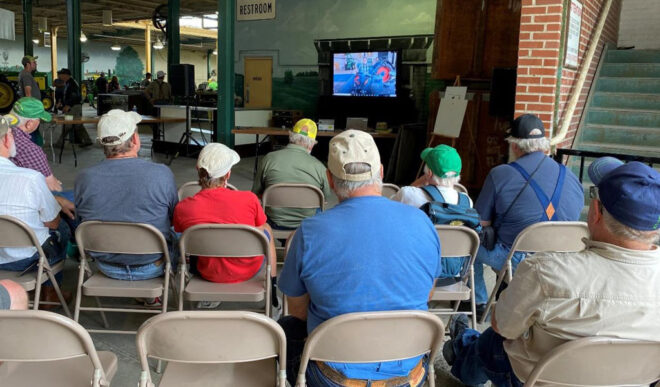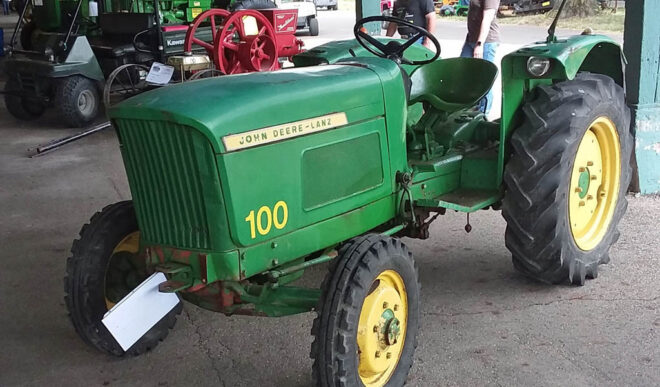When the German Agricultural Society‘s (DLG) travelling exhibition opened its doors on 16 June 1921, the Heinrich Lanz company presented the Bulldog HL 12 for the first time. In keeping with the philosophy of its inventor, Dr Fritz Huber, that an agricultural tractor cannot be too “single-cylinder”, it was hard to beat in terms of simplicity. The 12hp hot-bulb engine with only one cylinder drove the rear wheels via a chain. There was no gearbox. To reverse, the motor’s direction of rotation was changed.

Dr Fritz Huber: Inventor and designer of the Bulldog.
To do this, the engine was brought almost to a standstill and then accelerated again when the piston was in the right position. Mr Lanz kept to the concept of the horizontal two-stroke single-cylinder engine until the end of the Bulldog era around 60 years ago. The hot-bulb engine also gave the machine its name, as the shape of the cylinder head resembles a dog’s nose.
To start the Bulldog, the lower part of the hot bulb was heated with a soldering or heating lamp until it glowed red at around 700 to 800°C. Only then was fuel pre-pumped manually and the engine started by hand at the flywheel. Although this procedure was time-consuming, it didn’t take much longer than harnessing up draft animals.
A superb test run from Mannheim to Berlin
Another great advantage of the hot-bulb engine is that it runs on any fuel that is liquid and combustible. This also includes vegetable and waste oil or spirit. This proto-Bulldog was offered either with solid rubber tyres or profiled iron wheels.
In 1925, Mr Lanz organised a test drive from Mannheim to Berlin to publicly demonstrate the Bulldog’s reliability. After 17 days and over 1,000km, the train of three HL 12s and a 38hp “Felddank” tractor reached the Brandenburg Gate.

A combination “Kombi-Bulldog” for field and road from 1932.
The HL 12 proved to be ideally suited for transport work and driving threshing machines. On the other hand, it could only be used to a limited extent in the field. To counter this, in 1923, Mr Lanz introduced the Acker-Bulldog HP with four-wheel drive.
This was the first tractor with articulated steering, as found today in our large 9R Series tractors. Dr Huber even patented this drive concept in the USA in 1924, although Mr Lanz never exported Bulldogs to the States. At around 5,000 gold marks, the HP Bulldog was relatively expensive, especially as the price had to be paid in US dollars.
From 1926 onwards, Mr Lanz therefore turned increasingly to large-scale enterprises, as these were less sceptical of mechanisation. With the HR 2, the company introduced the first of the famous 10-litre Bulldogs in 1927. This delivered a maximum of 28hp and had a gearbox with four gears which could be used forwards and backwards. The front axle of the all-rubber-tyred traffic version already had suspension at that time. In order to produce more efficiently and to meet demand, this tractor was the first vehicle in Germany to be built on an assembly line.

A typical sight until the 1950s: The transport “Verkehrs-Bulldog” with threshing machine and baler.
Cooler Bulldogs for hotter regions
The Bulldogs did not have a closed cooling circuit until 1928, so the cooling water simply evaporated. This made it difficult to use the Bulldogs in hot, dry regions. It was not until the HR 4 that Mr Lanz offered a Bulldog with a radiator cooler, which was initially exported to these regions. However, these “cooler bulldogs” soon also established themselves in more temperate climates. Another innovation was that the gearbox now offered three forward gears and one reverse gear.

The speedy “Eil-Bulldog” was also popular outside agriculture.
While the 10-litre Bulldogs were mainly used on large farms and for transport, from 1931 Mr Lanz again offered a tractor for medium-sized farms with the HN series. It had an engine with a capacity of 4.7 litres, with 20hp in the beginning. In the course of development, the power was increased to 35hp.
Further innovation came at the beginning of the 1930s, with first the transport and then soon also the agricultural Bulldogs being offered with pneumatic tyres. This not only brought a considerable gain in traction and comfort, but also allowed significantly higher speeds. In 1934, Mr Lanz put a speedy “Eil-Bulldog” on the market for the first time. Until the 1950s, these were the typical means of transport for showmen, sawmillers and coal merchants. Another new development in the early 1930s were the caterpillar Bulldogs.
A 15hp “Farmer’s Bulldog”
For small farms, from 1939 Mr Lanz offered the “Farmer’s Bulldog”, or the “BauernBulldog” – as it was officially called – type D 4506 with 15hp. It was the first Bulldog that he offered with a hitch. The hoped-for large-scale production failed to materialise, as Bulldog production came to a standstill as a result of the war. The first new development after the war, the D 5506 presented in 1950, was technically based on the D 4506. From 1952, the new semi-diesel engine replaced the hot bulb – initially in the small models and later also in the larger Bulldogs.

Lanz introduced the last hot-bulb Bulldog in 1950 with the D 5506.
The designation “semi-diesel” comes from the fact that these engines were started with more ignition-friendly petrol. Once the engine had warmed up, it continued to run on diesel. Time-consuming preheating and start-up was therefore no longer necessary. Mr Lanz also offered conversion kits to equip older hot-bulb Bulldogs with the new engines.
In addition to the classic Bulldogs, Mr Lanz also offered the “Alldog” attachment carrier from 1951 and the “Bulli” compact tractor from 1955. Both were primarily intended for small farms, which were often still working with draft animals. For example, advertisers liked to emphasise that such a tractor was more economical to run than two horses. The attachment carriers were characterised by the fact that the implements were mounted on the front of the support frame and the driver always had them in view.
For some models, the ‚dogma‘ of the single cylinder was abandoned and two-cylinder engines from MWM (Motoren-Werke Mannheim) were installed. The last Bulldog generation to come onto the market from 1955 were the full diesel models with 16 to 40hp, for which a hydraulic three-point linkage was now also offered. These machines were started with diesel after a short pre-heating process, so it was no longer necessary to switch the fuel.

An Alldog during beet harvest.
A tractor with a future
The 200,000th Bulldog, a D 2416, rolled off the production line in Mannheim in 1956. In the same year, John Deere acquired the majority of shares in Heinrich Lanz AG. Two years later, the Bulldogs were delivered in the colours green and yellow. In 1960, John Deere-Lanz AG, as the company was now called, introduced its first new developments – the 300 with 28hp and 500 with 36hp.

A success: In 1956, the 200,000th Bulldog rolled off the assembly line in Mannheim.
The new “tractors with a future”, as the advertising slogan said at the time, had modern four-cylinder in-line engines, a 10-speed transmission and modern control hydraulics. The D 5016 and D 6016 semi-diesel models continued to be produced until 1962; in Getafe, Spain, Bulldog production continued until 1963.
Although the Lanz Bulldog may seem antiquated today, in its day it was a real innovation. Especially during the interwar period and directly after the Second World War, it made a decisive contribution to the mechanisation of agriculture. This is not only evident in the exports to countries around the globe, but also in several licensed constructions and copies, such as Ursus in Poland, Pampa in Argentina or Kelly & Lewis in Australia. The Bulldog will always remain legendary, not least because of the noise it made.
Lanz Fans in the USA: “Simply exceptional”

Although Lanz tractors have never been sold in the USA, there is a small and enthusiastic fan community there which meets and organises, among other things, antique tractor shows. Chris Boyens is jointly responsible for one of these events. Together with his fellow campaigners, he has launched the Classic Green Club, which brings together John Deere’s enthusiasts across all model and equipment ranges. At the last major event, the Classic Green Reunion 2021 in Ohio, 3,000 visitors came together to marvel at around 800 machines and attachments and to swap ideas. Mr Boyens explains: “Old tractors have a special fascination for many people: Their simplicity, the stories associated with them. It brings the people here together.
One special highlight of the last Classic Green Reunion was made up by four Lanz tractors, which attracted a lot of attention, and not only because it was the brand’s 100th anniversary. Graham Thompson, who brought one of the four Lanz tractors to Ohio, says: “The most frequent question was why do you have blue tractors at a green event? It was often the starting point of a conversation where many people were completely surprised to learn that Lanz tractors are part of the John Deere family.”
Messrs. Boyens and Thompson also provided this and other information during their own presentation on 100 years of Lanz. They were supported by a video message from the expert for John Deere history in Mannheim, Christian Quick. But what is it about Lanz tractors that fascinates Mr Thompson? “From the design and robust construction, to the very specific sound: These tractors are exceptional.”





